Photosynthesis is defined as the process, utilized by green plants and photosynthetic bacteria, where electromagnetic radiation is converted into chemical energy and uses light energy to convert carbon dioxide and water into carbohydrates and oxygen.

- The carbohydrates formed from photosynthesis provide not only the necessary energy form the energy transfer within ecosystems, but also the carbon molecules to make a wide array of biomolecules.
- Photosynthesis is a light-driven oxidation-reduction reaction where the energy from the light is used to oxidize water, releasing oxygen gas and hydrogen ions, followed by the transfer of electrons to carbon dioxide, reducing it to organic molecules.
- Photosynthetic organisms are called autotrophs because they can synthesize chemical fuels such as glucose from carbon dioxide and water by utilizing sunlight as an energy source.
- Other organisms that obtain energy from other organisms also ultimately depend on autotrophs for energy.
- One of the essential requirements for photosynthesis is the green pigment ‘chlorophyll’ which is present in the chloroplasts of green plants and some bacteria.
- The pigment is essential for ‘capturing’ sunlight which then drives the overall process of photosynthesis.
Interesting Science Videos
Photosynthesis equations/reactions/formula
- The process of photosynthesis differs in green plants and sulfur bacteria.
- In plants, water is utilized along with carbon dioxide to release glucose and oxygen molecules.
- In the case of sulfur bacteria, hydrogen sulfide is utilized along with carbon dioxide to release carbohydrates, sulfur, and water molecules.
Oxygenic Photosynthesis
The overall reaction of photosynthesis in plants is as follows:
Carbon dioxide + Water + solar energy → Glucose + Oxygen
6CO2 + 6H2O + solar energy → C6H12O6 + 6O2
OR
Carbon dioxide + Water + solar energy → Glucose + Oxygen + Water
6CO2 + 12H2O+ solar energy → C6H12O6 + 6O2 + 6H2O
Anoxygenic Photosynthesis
The overall reaction of photosynthesis in sulfur bacteria is as follows:
CO2 + 2H2S + light energy → (CH2O) + H2O + 2S
Video Animation: Photosynthesis (Crash Course)
Photosynthetic pigments
- Photosynthetic pigments are the molecules involved in absorbing electromagnetic radiation, transferring the energy of the absorbed photons to the reaction center, resulting in photochemical reactions in the organisms capable of photosynthesis.
- The molecules of photosynthetic pigments are quite ubiquitous and are always composed of chlorophylls and carotenoids.
- In addition to chlorophyll, photosynthetic systems also contain another pigment, pheophytin (bacteriopheophytin in bacteria), which plays a crucial role in the transfer of electrons in photosynthetic systems.
- Moreover, other pigments can be found in particular photosynthetic systems, such as xanthophylls in plants.
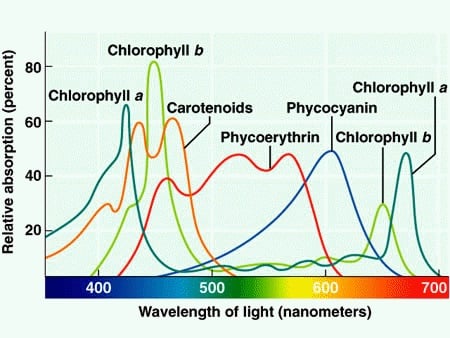
Image Source: Simply Science.
Chlorophyll
- Chlorophyll is the pigment molecule, which is the principal photoreceptor in the chloroplasts of most green plants.
- Chlorophylls consist of a porphyrin ring, which is bounded to an ion Mg2+, attached to a phytol chain.
- Chlorophylls are very effective photoreceptors because they contain networks of alternating single and double bonds.
- In chlorophyll, the electrons are not localized to a particular atomic nucleus and consequently can more readily absorb light energy.
- In addition, chlorophylls also have solid absorption bands in the visible region of the spectrum.
- Chlorophylls are found either in the cytoplasmic membranes of photosynthetic bacteria, or thylakoid membranes inside plant chloroplasts.
Bacteriorhodopsin
- Bacteriorhodopsin is another class of photosynthetic pigment that exists only in halobacteria.
- It is composed of a protein attached to a retinal prosthetic group.
- This pigment is responsible for the absorption of light photons, leading to a conformational change in the protein, which results in the expulsion of the protons from the cell.
Phycobilins
- Cyanobacteria and red algae employ phycobilins such as phycoerythrobilin and phycocyanobilin as their light-harvesting pigments.
- These open-chain tetrapyrroles have the extended polyene system found in chlorophylls, but not their cyclic structure or central Mg2+.
- Phycobilins are covalently linked to specific binding proteins, forming phycobiliproteins, which associate in highly ordered complexes called phycobilisomes that constitute the primary light-harvesting structures in these microorganisms.
Carotenoids
- In addition to chlorophylls, thylakoid membranes contain secondary light-absorbing pigments, or accessory pigments, called carotenoids.
- Carotenoids may be yellow, red, or purple. The most important are β-carotene, which is a red-orange isoprenoid, and the yellow carotenoid lutein.
- The carotenoid pigments absorb light at wavelengths not absorbed by the chlorophylls and thus are supplementary light receptors.
Factors affecting photosynthesis
Blackman formulated the Law of limiting factors while studying the factors affecting the rate of photosynthesis. This Law states that the rate of a physiological process will be limited by the factor which is in the shortest supply. In the same way, the rate of photosynthesis is also affected by a number of factors, which are namely;
Light
- As the intensity of light increases, the rate of light-dependent reactions of photosynthesis and in turn, the rate of photosynthesis increases.
- With increased light intensity, the number of photons falling on a leaf also increases. As a result, more chlorophyll molecules are ionized, and more ATPs and NADH are generated.
- After a point, however, the rate of photosynthesis remains constant as the light intensity increases. At this point, photosynthesis is limited by some other factors.
- Besides, the wavelength of light also affects the rate of photosynthesis.
- Different photosynthetic systems absorb light energy more effectively at different wavelengths.
Carbon dioxide
- An increase in the concentration of carbon dioxide increases the rate at which carbon is incorporated into carbohydrates in the light-independent reactions of photosynthesis.
- Thus, increasing the concentration of carbon dioxide in the atmosphere rapidly increases the rate of photosynthesis up to a point after which it is limited by some other factors.
Temperature
- The light-independent reactions of photosynthesis are affected by changes in temperature as they are catalyzed by enzymes, whereas the light-dependent reactions are not.
- The rate of the reactions increases as the enzymes reach their optimum temperature, after which the rate begins to decrease as the enzymes tend to denature.
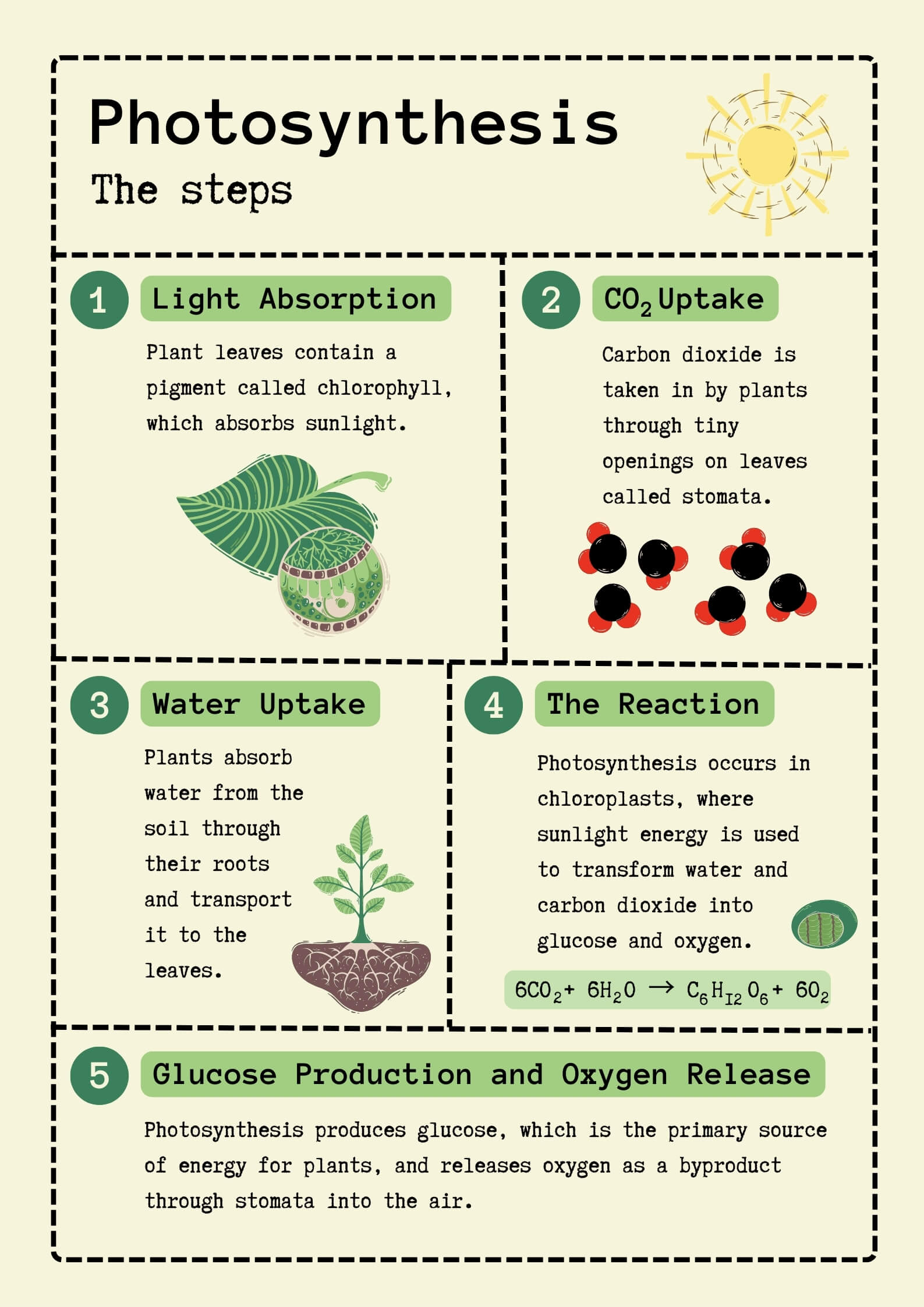
Process/ Steps of Photosynthesis
The overall process of photosynthesis can be objectively divided into four steps/ process:
1. Absorption of light
- The first step in photosynthesis is the absorption of light by chlorophylls that are attached to the proteins in the thylakoids of chloroplasts.
- The light energy absorbed is then used to remove electrons from an electron donor like water, forming oxygen.
- The electrons are further transferred to a primary electron acceptor, quinine (Q) which is similar to CoQ in the electron transfer chain.
2. Electron Transfer
- The electrons are now further transferred from the primary electron acceptor through a chain of electron transfer molecules present in the thylakoid membrane to the final electron acceptor, which is usually NADP+.
- As the electrons are transferred through the membrane, protons are pumped out of the membrane, resulting in the proton gradient across the membrane.
3. Generation of ATP
- The movement of protons from the thylakoid lumen to the stroma through the F0F1 complex results in the generation of ATP from ADP and Pi.
- This step is identical to the step of the generation of ATP in the electron transport chain.
4. Carbon Fixation
- The NADP and ATP generated in steps 2 and 3 provide energy, and the electrons drive the process of reducing carbon into six-carbon sugar molecules.
- The first three steps of photosynthesis are directly dependent on light energy and are thus, called light reactions, whereas the reactions in this step are independent of light and thus are termed dark reactions.
Types/ Stages/ Parts of photosynthesis
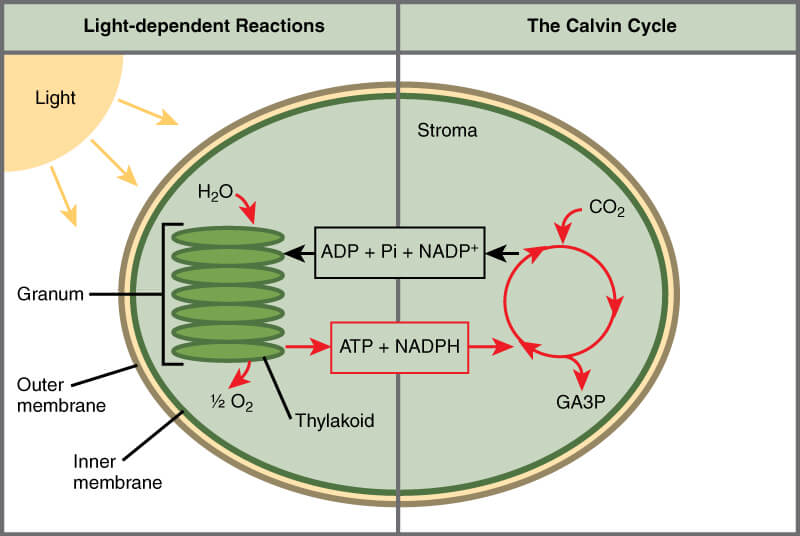
Figure: Photosynthesis takes place in two stages: light-dependent reactions and the Calvin cycle. Light-dependent reactions, which take place in the thylakoid membrane, use light energy to make ATP and NADPH. The Calvin cycle, which takes place in the stroma, uses energy derived from these compounds to make GA3P from CO2. Image Source: OpenStax (Rice University).
Photosynthesis is divided into two stages based on the utilization of light energy:
1. Light-dependent reactions
- The light-dependent reactions of photosynthesis only take place when the plants/ bacteria are illuminated.
- In the light-dependent reactions, chlorophyll and other pigments of photosynthetic cells absorb light energy and conserve it as ATP and NADPH while simultaneously, evolving O2 gas.
- In the light-dependent reactions of photosynthesis, the chlorophyll absorbs high energy, short-wavelength light, which excites the electrons present inside the thylakoid membrane.
- The excitation of electrons now initiates the transformation of light energy into chemical energy.
- The light reactions take in two photosystems that are present in the thylakoid of chloroplasts.
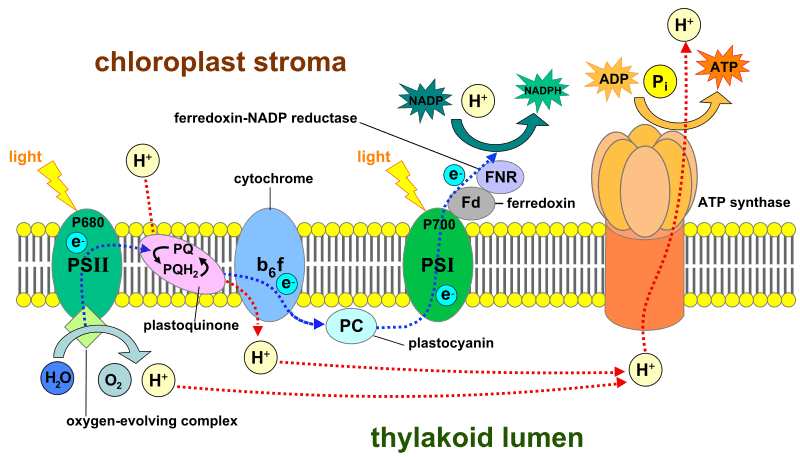
Figure: Light-dependent reactions of photosynthesis in the thylakoid membrane of plant cells. Image Source: Wikipedia (Somepics).
Photosystem II
- Photosystem II is a group of proteins and pigments that work together to absorb light energy and transfer electrons through a chain of molecules until it finally reaches an electron acceptor.
- Photosystem II has a pair of chlorophyll molecules, also known as P680 as the molecules best absorb light of the wavelength 680 nm.
- The P680 donates a pair of electrons after absorbing light energy, resulting in an oxidized form of P680.
- Finally, an enzyme catalyzes the splitting of a water molecule into two electrons, two hydrogen ion, and oxygen molecules.
- This pair of electrons then are transferred to P680, causing it to return to its initial stage.
Photosystem I
- Photosystem I is a similar complex like photosystem II except for that photosystem I have a pair of chlorophyll molecules known as P700 as they best absorb the wavelength of 700 nm.
- As photosystem I absorb light energy, it also becomes excited and transfers electrons.
- The now oxidized form of P700 then accepts an electron from photosystem II, restring back to its initial stage.
- The electrons from photosystem I are then passed in a series of redox reactions through the protein ferredoxin.
- The electrons finally reach NADP+, reducing them to NADPH.
Reaction
2 H2O + 2 NADP+ + 3 ADP + 3 Pi + light → 2 NADPH + 2 H+ + 3 ATP + O2
Video Animation: The Light Reactions of Photosynthesis (Ricochet Science)
2. Light independent reactions (Calvin cycle)
Light independent reactions of photosynthesis are anabolic reactions that lead to the formation of a sex-carbon compound, glucose in plants. The reactions in this stage are also termed dark reactions as they are not directly dependent on the light energy but do require the products formed from the light reactions.
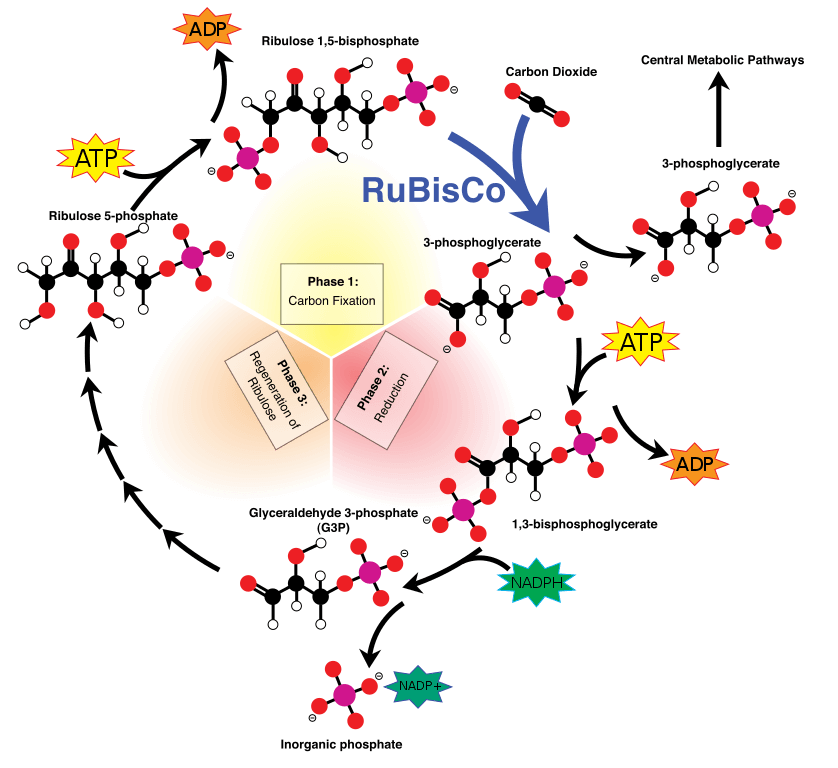
Figure: Overview of the Calvin cycle pathway. Image Source: Wikipedia (Mike Jones).
This stage consists of 3 further steps that lead to carbon fixation/ assimilation.
Step 1: Fixation of CO2 into 3-phosphoglycerate
- In this step, one CO2 molecule is covalently attached to the five-carbon compound ribulose 1,5-biphosphate catalyzed by the enzyme ribulose 1,5-biphosphate carboxylase, also called rubisco.
- The attachment results in the formation of an unstable six-carbon compound that is then cleaved to form two molecules of 3-phosphoglycerate.
Step 2: Conversion of 3-phosphoglycerate to glyceraldehydes 3-phosphate
- The 3-phosphoglycerate formed in step 1 is converted to glyceraldehyde 3-phosphate by two separate reactions.
- At first, enzyme 3-phosphoglycerate kinase present in the stroma catalyzes the transfer of a phosphoryl group from ATP to 3-phosphoglycerate, yielding 1,3-bisphosphoglycerate.
- Next, NADPH donates electrons in a reaction catalyzed by the chloroplast-specific isozyme of glyceraldehyde 3-phosphate dehydrogenase, producing glyceraldehyde 3-phosphate and phosphate (Pi).
- Most of the glyceraldehyde 3-phosphate thus produced is used to regenerate ribulose 1,5-bisphosphate.
- The rest of the glyceraldehyde is either converted to starch in the chloroplast and stored for later use or is exported to the cytosol and converted to sucrose for transport to growing regions of the plant.
Step 3: Regeneration of ribulose 1,5-biphosphate from triose phosphates
- The three-carbon compounds formed in the previous steps are then converted into the five-carbon compound, ribulose 1,5-biphosphate through a series of transformations with intermediates of three-, four,-, five-, six-, and seven-carbon sugar.
- As the first molecules in the process, if regenerated, this stage of photosynthesis results in a cycle (Calvin cycle).
Reaction
3 CO2 + 9 ATP + 6 NADPH + 6 H+ → glyceraldehyde-3-phosphate (G3P) + 9 ADP + 8 Pi + 6 NADP+ + 3 H2O
A G3P molecule contains three fixed carbon atoms, so it takes two G3Ps to build a six-carbon glucose molecule. It would take six turns of the cycle to produce one molecule of glucose.
Video Animation: The Calvin Cycle (Ricochet Science)
Products of Photosynthesis
The outcomes of light-dependent reactions of photosynthesis are:
- ATP
- NADPH
- O2
- H+ ions
The products of light-independent reactions (Calvin cycle) of photosynthesis are:
- glyceraldehyde-3-phosphate (G3P) / Glucose (carbohydrates)
- H+ ions
The overall products of photosynthesis are:
- Glucose (carbohydrates)
- Water
- Oxygen
- Sulfur (in photosynthetic sulfur bacteria)
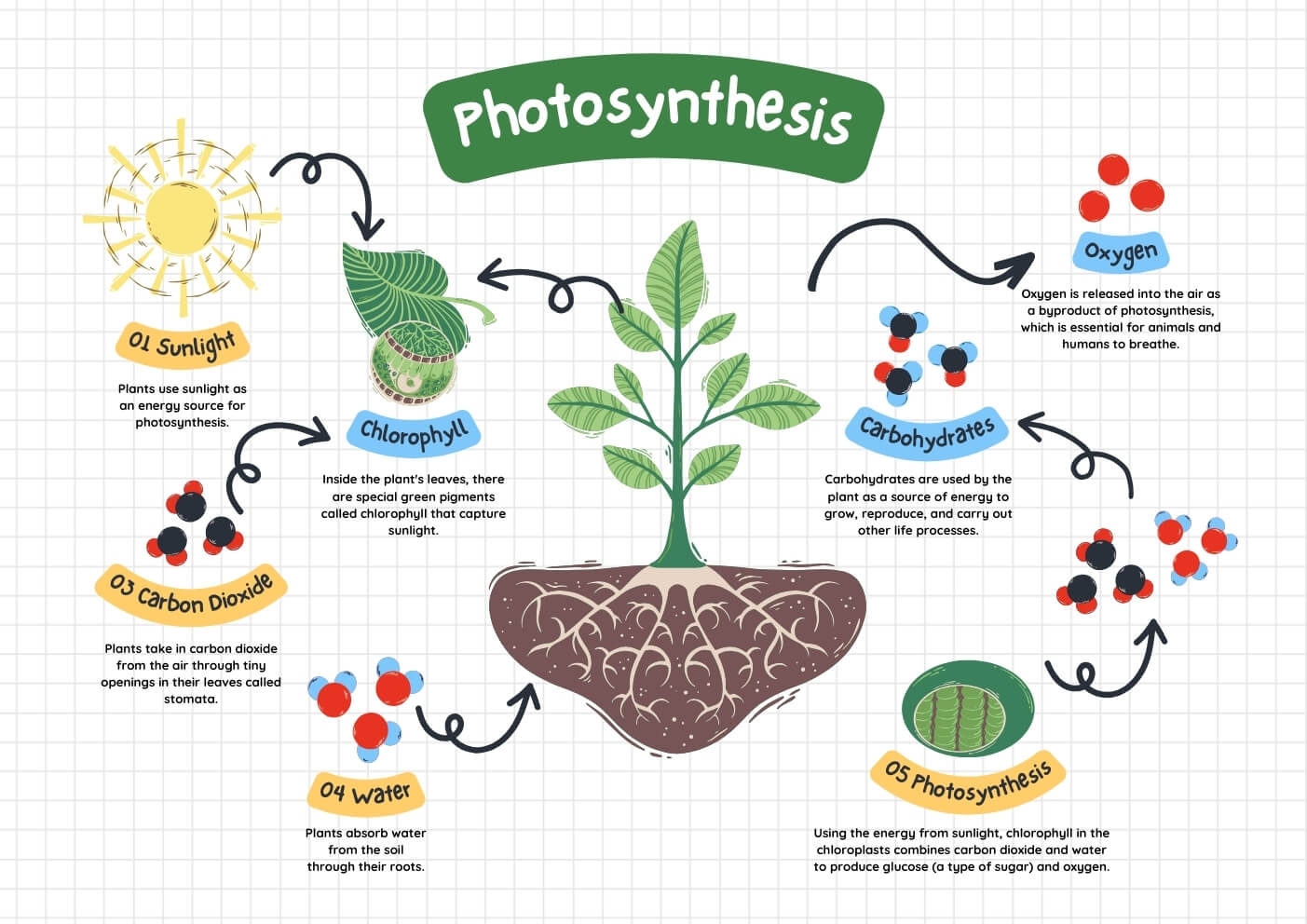
Photosynthesis Examples
Photosynthesis in green plants or oxygenic bacteria
- In plants and oxygenic bacteria like cyanobacteria, photosynthesis takes place in the presence of green pigment, chlorophyll.
- It takes place in the thylakoids of the chloroplasts, resulting in products like oxygen gas, glucose, and water molecules.
- Most of the glucose units in plants are linked to form starch or fructose or even sucrose.
Photosynthesis in sulfur bacteria
- In purple sulfur bacteria, photosynthesis takes place in the presence of hydrogen sulfur rather than water.
- Some of these bacteria like green sulfur bacteria have chlorophyll whereas other purple sulfur bacteria have carotenoids as photosynthetic pigments.
- The result of photosynthesis in these bacteria are carbohydrates (not necessarily glucose), sulfur gas, and water molecules.
Importance of photosynthesis
- Photosynthesis is the primary source of energy in autotrophs where they make their food by utilizing carbon dioxide, sunlight, and photosynthetic pigments.
- Photosynthesis is equally essential for heterotrophs, as they derive their energy from the autotrophs.
- Photosynthesis in plants is necessary to maintain the oxygen levels in the atmosphere.
- Besides, the products of photosynthesis contribute to the carbon cycle occurring in the oceans, land, plants, and animals.
- Similarly, it also helps maintain a symbiotic relationship between plants, animals, and humans.
- Sunlight or solar energy is the primary source of all other forms of energy on earth, which is utilized through the process of photosynthesis.
Artificial photosynthesis
Artificial photosynthesis is a chemical process that mimics the biological process of utilization of sunlight, water and carbon dioxide to produce oxygen and carbohydrates.
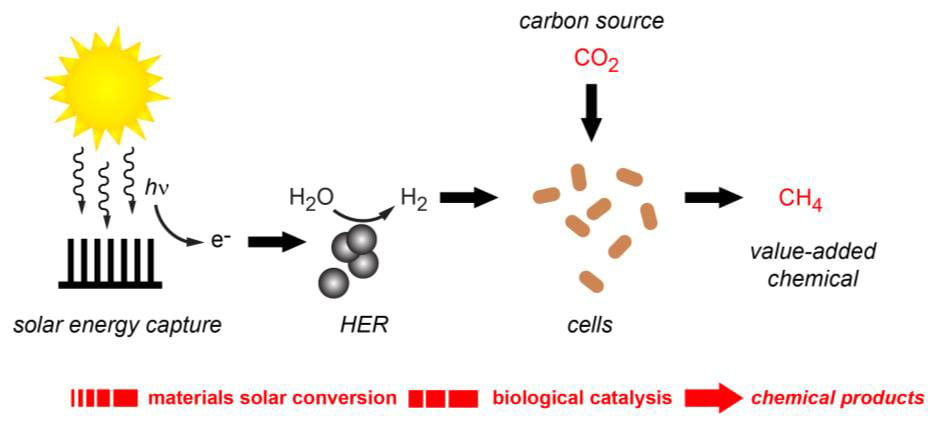
Image Source: Phys.
- In artificial photosynthesis, photocatalysts are utilized that are capable of replicating the oxidation-reduction reactions taking place during natural photosynthesis.
- The main function of artificial photosynthesis is to produce solar fuel from sunlight that can be stored and used under conditions, where sunlight is not available.
- As solar fuels are prepared, artificial photosynthesis can be used to produce just oxygen from water and sunlight, resulting in clean energy production.
- The most important part of artificial photosynthesis is the photocatalytic splitting of a water molecule, resulting in oxygen and large quantities of hydrogen gas.
- Further, light-driven carbon reduction can also be performed to replicate the process of natural carbon fixation, resulting in carbohydrates molecules.
- Thus, artificial photosynthesis has applications in the production of solar fuels, photoelectrochemistry, engineering of enzymes, and photoautotrophic microorganisms for the production of microbial biofuel and biohydrogen from sunlight.
Video Animation: Learning from leaves: Going green with artificial photosynthesis
Photosynthesis vs. Cellular respiration
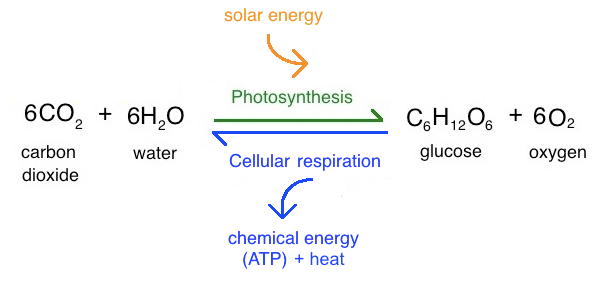
Image Source: Khan Academy.
Photosynthesis | Cellular respiration |
| Photosynthesis takes place in green plants, algae, and some photosynthetic bacteria. | Cellular respiration takes place in all living organisms. |
| The process of photosynthesis occurs in the thylakoids of chloroplasts. | The process of cellular respiration occurs in mitochondria. |
| The reactants of photosynthesis are light energy, carbon dioxide, and water. 6CO2 + 6H2O → C6H12O6 + 6O2 | The reactants of cellular respiration are glucose and oxygen. 6O2 + C6H12O6 → 6CO2 + 6H2O |
| The products of photosynthesis are glucose and oxygen. | The products of cellular respiration are carbon dioxide and water. |
| Photosynthesis is an anabolic process, resulting in the production of organic molecules. | Cellular respiration is a catabolic process, resulting in the oxidation of organic molecules to release energy. |
| Photosynthesis is an endergonic reaction that results in the utilization of energy. | Cellular respiration is an exergonic reaction that results in the release of energy |
| Photosynthesis can only take place in the presence of sunlight. | Cellular respiration occurs all the time as it doesn’t require sunlight. |
Video Animation: Photosynthesis vs. Cellular Respiration Comparison (BOGObiology)
FAQs (Revision Questions)
Where does photosynthesis occur?
Photosynthesis occurs in the thylakoid membrane of the chloroplasts.
What are the products of photosynthesis?
The products of photosynthesis are carbohydrates (glucose), oxygen, and water molecules.
What are the reactants of photosynthesis?
The reactants of photosynthesis are carbon dioxide, water, photosynthetic pigments, and sunlight.
How are photosynthesis and cellular respiration related?
Photosynthesis and cellular respiration are essentially the reverses of one another where photosynthesis is an anabolic process resulting in the formation of organic molecules. In contrast, cellular respiration is a catabolic process resulting in the breaking down of organic molecules to release energy.
References
- Berg JM, Tymoczko JL, Stryer L. Biochemistry. 5th edition. New York: W H Freeman; 2002. Section 17.2, Entry to the Citric Acid Cycle and Metabolism Through It Are Controlled.Available from: https://www.ncbi.nlm.nih.gov/books/NBK22347/
- Nelson DL and Cox MM. Lehninger Principles of Biochemistry. Fourth Edition.
- Montero F. (2011) Photosynthetic Pigments. In: Gargaud M. et al. (eds) Encyclopedia of Astrobiology. Springer, Berlin, Heidelberg
- Lodish H, Berk A, Zipursky SL, et al. Molecular Cell Biology. 4th edition. New York: W. H. Freeman; 2000. Section 16.3, Photosynthetic Stages and Light-Absorbing Pigments.Available from: https://www.ncbi.nlm.nih.gov/books/NBK21598/






How can we say that 6 calvin cycles are needed to produce 1 glucose molecule why not 2?